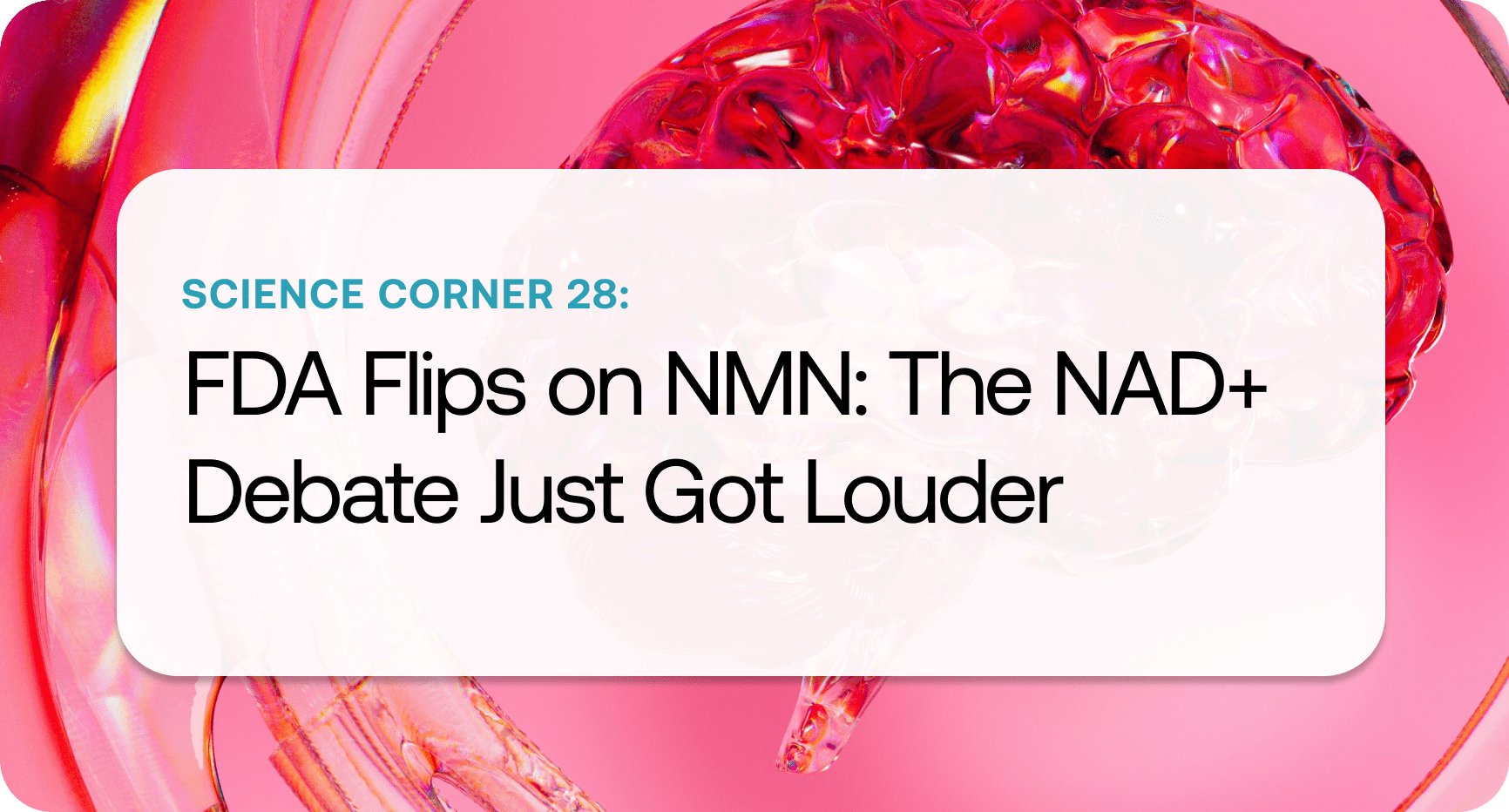Science Corner 28 | FDA Flips on NMN: The NAD+ Debate Just Got Louder

The FDA has officially declared nicotinamide mononucleotide (NMN) legal in dietary supplements.
That’s a big shift.
Back in 2022, the agency said NMN couldn’t be sold because drug trials had already begun. But after confirming NMN was sold in the U.S. market as early as 2017, before those trials started, the FDA reversed its stance. With this one decision, NMN is back on shelves.
Industry insiders are divided. Some see this as a win for consumer access. Others worry it blurs the line between supplements and drugs. But for consumers, the bigger story is what comes next: the NAD+ supplement race is heating up.
Why NAD+ matters
NAD+ (nicotinamide adenine dinucleotide) is a molecule your body relies on for energy, metabolism, and repairing DNA. As we age, NAD+ levels decline, and that drop is linked to fatigue, slower recovery, and age-related disease.
That’s why NAD+ boosters have exploded in popularity. Two ingredients dominate the conversation: nicotinamide riboside (NR) and nicotinamide mononucleotide (NMN). With FDA’s decision, both are now legal options, but they aren’t identical.
NMN vs. NR: What’s the difference?
You’ll often hear that NMN is the “more direct” path to NAD+. NR, by comparison, needs to be converted into NMN first, then into NAD+. On paper, that makes NMN sound like the better choice.
But the biology is more complicated.
Getting into cells: NR can enter cells directly. NMN’s pathway is less certain. Some studies suggest NMN must first convert into NR to get inside, then change back once it’s there.
Evidence: NR has been studied longer in humans. It consistently raises NAD+ in blood, sometimes by 40-60%, and appears safe even at high doses. Benefits include better mitochondrial function, improved liver health, and support for cardiovascular markers. NMN has fewer studies but is catching up. Early results show it also raises NAD+ and may improve insulin sensitivity, muscle energy, and fatigue. Safety looks good so far, though the research isn’t as deep as NR’s.
How they act in the body: Some data suggest NR works more in the liver, while NMN may support muscle more directly. If true, that could eventually matter depending on whether your focus is metabolic health or physical performance.
Formulation & cost: NR is stable and easy to put in capsules. NMN is more fragile, so companies often sell it in sublingual (under the tongue) powders, liposomal liquids, or coated tablets. NR usually carries a premium price (tied to branded versions like Niagen®), while NMN is often cheaper in bulk, but quality can vary a lot.
The quality problem
At SuppCo, we recently tested NAD+ supplements and found many products didn’t live up to their labels. Some had much less of the ingredient than promised. Others raised safety concerns.
Read the full SuppCo Tested Report on NAD+ here.
With NMN now back on the market, more products will flood in. That means more choice for consumers, but also a higher chance of low-quality supplements slipping through.
What this means for you
The FDA’s decision doesn’t answer the key question: which precursor is better? Both NMN and NR can raise NAD+. Both look safe. Both have promise, but neither is proven to deliver the sweeping “anti-aging” claims you might see in ads.
For now, the real challenge isn’t choosing sides. It’s cutting through the hype to find products that actually deliver what they promise.
And this may be only the beginning. As more “longevity molecules” move from labs into supplements, we’ll likely see more regulatory shifts, more contenders, and more confusion. The next chapter in the NAD+ story will be written not just in science, but in how carefully consumers, and the industry, handle this moment of opportunity.
--
Personal note from Jordan
For me, this decision feels like the starting gun of a new phase in supplements. With NMN officially back in play, the NAD+ space is no longer just a quiet corner of research, it has opened into a wide frontier where consumers have more power than ever to chart their own course. The science will continue to unfold through rigorous clinical trials, which will help us refine our understanding of how NMN, NR, and other precursors actually work in the body. But equally important is the role of individuals who now have the freedom to experiment, compare, and make informed decisions for themselves.
This is where things get exciting. For some, it will mean trying NMN alongside NR to see if the differences in biology translate to differences in lived experience. For others, it will be about carefully testing dosages, formats, and timing to find the best personal fit. It is a rare moment when the lines between formal science and self-experimentation overlap so closely, and it empowers consumers to become active participants rather than passive recipients of health innovation.
In many ways, NAD+ just expanded the wild west of longevity, with risks, opportunities, and discoveries waiting on every horizon. What comes next will be shaped not only by what researchers publish, but by how people like you and me choose to explore this new freedom. I am genuinely excited to watch it unfold.
